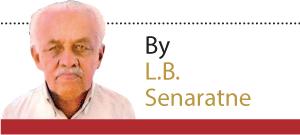Reply To:
Name - Reply Comment
Current research underscores that Sri Lanka is the only country to have maintained a developed status continuously
A version of the Maha vansha has surfaced in Germany and it is alleged to have been written by the priests of ‘Uththaramaha vihare Wansa’. And if it is found it would complete the chronicled history of Sri Lanka, according to Prof. Rohitha Dissanayake- the Head of the Department of History at the University of Peradeniya.
chronicled history of Sri Lanka, according to Prof. Rohitha Dissanayake- the Head of the Department of History at the University of Peradeniya.
This information was conveyed to this writer by Dissanayake after the unveiling ceremony of the Plaque by the Director General of UNESCO Audrey Azoulay.
Dissanayake said that he is requesting the assistance of UNESCO to gain access to other significant manuscripts held in foreign institutions to further the understanding and preservation of Sri Lanka’s rich historical heritage.
Prof. Dissanayake further told this writer that he along with others in the fraternity of antiquarians is alert regarding the reports that this version of the Maha vansha (surfaced in Germany) – must adhere to a number of old documents.
The Maha vansha is so important to understand the early history of not only Sri Lanka, but also neighbouring India, which lacks a similarly continuous historical record. This Chronicle has never engaged in racial or religious bias exemplified by the respect it records to Dravidian King Elara, whose grave was honoured until 1818- a testament to the authors’ impartiality.
A red carpet welcome awaited Azoulay who was received by the Vice Chancellor Prof. M.D. Lamawansa at the new building of the University Library. Here is stored the Ola Leaf manuscripts under Assistant Librarian Herath. Madam Azoulay, having seen the Ola Leaf manuscripts with the Vice Chancellor Lamawansa, said that the books should be digitalised and if a request is made UNESCO is ready to provide all assistance.
The Maha vansha is crucial for the understanding of the history of this island; the Maha vansha’s global significance is not solely due to its documentation of Sinhalese or Buddhist history, it is recognised as a superior work.
The history of the findings of the Maha vansha dates back to the period when the University was shifted to Peradeniya. Then the first Librarian was Dr. S.D. Somadasa. He had seen the ‘Ola leafs’ amounting to about 2300 in number, but had left them as this manuscript was available in the temples as well. However no serious effort was made to go further than preserve the copies available at the Library.
Then the present Chief Librarian Dr. Rasiah Maheswaran, with the help of then Vice Chancellor Prof. Upul Dissanayake approved a project to ‘Blacken the Ola Leaf books’ since the writings were fading away.
Then a team from UNESCO visited the University Library who saw the Ola leaf books and the process of ‘Blackening the leaves’; which was no easy task. Back then it was a time when the interest for the Maha vansha was growing.
Prof. Dissanayake said that the National Library Services Board played a pivotal role in this gigantic endeavour. A dedicated panel of scholars from this institution undertook an examination of over 100 different temples. They did their studies for a period of over two years to ascertain the authentic copies of the Maha vansha.
Then choosing the best copy of this chronicle fell on the shoulders of a team of dedicated men. The team included Prof. Rohita Dissanayake, Senior Prof. Mahinda Somatilleke and U.S.Y. Sahan Mahesh.
There was one chronicle from the Temple of the Tooth and three from the Library of the University of Peradeniya.
Prof. Dissanayake said that after meticulous scrutiny, this particular Ola Leaf manuscript, stood out for its exceptional essay style comprehensive composition and the seamless continuity
|
Director General of UNESCO Audrey Azoulay (closest to the camera) examines the only copy of the Maha vansha that has been accepted by UNESCO as the authentic record of the chronicled history of Sri Lanka.
|
of its chapters; accounting the period from the 6th Century BC to 1815 AD. This manuscript consisting of 237 pages was crafted by at least three authors.
Prof. Dissanyake said that the Maha vansha- as published by UNESCO- is a unique historical chronicle spanning from 6th Century BC to 1815 AD. Unlike other nations such as China, which has recorded its history under varying titles, Sri Lanka’s continuous historical narrative has been maintained in a single chronicle: The Maha vansha.
The Maha vansha is crucial for the understanding of the history of this island. The Maha vansha’s global significance is not solely due to its documentation of Sinhalese or Buddhist history. It is recognised as a superior work. Even 800 years ago there was evidenced of it. European scholars of the19th Century, included individuals in the likes of George Turner, James Prince, Herman Oldenberg and Wilelm Geiger, who translated the Maha vansha into English; thereby facilitating its study by western schlolars.
In fact current research underscores that Sri Lanka is the only country to have maintained a developed status continuously or 1000 years, with Anuradhapura being the world’s longest serving capital city. Foreign sources also attest to ancient Sri Lanka’s wealth and the Maha vansha stands as a primary testament to this legacy. This chronicle epitomises the zenith of literacy in a developed Nation.
This version of the Maha vansha –the chronicle of Sri Lanka- had gone into the annals of the UNESCO list of documents. It was in July 2023, that UNESCO named the Maha vansha among the 64 new items of documentary in UNESCO’s Memory of the World’s International Register.
The event was graced by scholars, dons both past and present, the Chancellor of the Peradeniya University Prof. Gerald Peiris, Buddhist monks, the Basnayake Nilames of Maha Vishnu Devale Manendra Ratwatte, Basnayake Nilame of Kataragama Devale Damitha Udurawana and other distinguished invitees.